Killing Floor 3 Güçlü Bir Başlangıç Yaptı Ama Yarıda Bırakılmış Gibi Görünüyor
Killing Floor 3 is a slick, fast-paced co-op shooter with refined movement, fun classes, and satisfying weapons, but the limited content and odd progression make it feel more like a polished Early Access version than a full release. The game nails the core of blasting through waves of mutant Zeds, especially with a solid team, but after just a few hours, most players will have seen everything it has to offer. The loop is fun, but shallow.
In a recent IGN review, Gabriel Moss gave a thorough breakdown of the game’s launch state, highlighting the highs and lows of its Survival mode, streamlined mechanics, class design, and progression quirks. His experience mirrors what many returning fans are feeling: Killing Floor 3 plays better than ever, but its narrow scope and odd balance choices make it tough to fully recommend without caveats.
Killing Floor 3 sticks closely to the formula of the previous games: survive five waves of mutant clone zombies, or "Zeds", before facing off against a brutal boss. That structure hasn’t changed, but Tripwire Interactive has given the gameplay loop a much-needed boost in pace. Movement is smoother, with faster dashing, sliding, climbing, and mid-combat mobility. Each match is tighter and more focused than in Killing Floor 2, but that improvement comes at the cost of depth.
What’s immediately clear is that this is a lean package. There’s just one game mode at launch —Survival. No campaign, no alternate story missions, and none of Killing Floor 2’s side modes like Objective Mode. It’s a good place for newcomers to jump in, since it avoids the bloated sprawl of the last entry, but veterans might be surprised by the lack of variety. There are six playable classes (called Perks), 30 weapons (plus the standard knife), 13 enemy types, eight maps, and three bosses. Enough for a few good weekends, but not much more.

The lone mode works well because the combat is sharp. Weapons feel punchy and satisfying, enemies explode with style, and the new physics system makes dismemberment and environmental damage feel more intense. The Zeds themselves are dangerous in groups but fall fast, giving players that rush of power before the pressure builds again. There’s constant movement, frequent danger, and lots of satisfying gore.
Each class has its own playstyle and tools. The Commando brings mid-range rifles, the Sharpshooter freezes targets and controls space, the Ninja excels in melee, the Firebug lights everything up, the Medic keeps the team alive with healing darts, and the Engineer plays support, setting up defenses and activating map utilities. Each one has its own special ability and grenade, along with passive perks that unlock as you level up. Even early levels add meaningful variety, letting players lean into different strategies fast.
This ties into a streamlined skill system. In Killing Floor 2, perks are unlocked every five levels. Here, new abilities come every two levels up to level 30. It’s a fast climb, and after just a few hours, players can already shape a class in specific directions. The Ninja, for example, can focus on self-healing parries and heavy-attack bonuses. The Sharpshooter might become a crouch-sniping ice queen. The class system works well and invites experimentation.

Unfortunately, weapon progression doesn’t hold up its end of the deal. There’s a weird disconnect between mid-match upgrades and the persistent Armory system in the hub area. In the Armory, you can permanently upgrade starter weapons with mods, turning basic gear into powerful tools right from the start of a match. That sounds cool—until you realize that the expensive, high-tier weapons you unlock later in the match are usually worse. Players end up sticking to tricked-out grey weapons instead of bothering with flashy purple gear. This imbalance makes the mid-match economy feel broken and removes the excitement of earning better equipment mid-run.
Another weak point is content volume. The eight maps look good and play well—each has a distinct layout, some with verticality or unique features like turrets and zip lines—but none really stand out. They're solid arenas, not memorable playgrounds. One favorite among players is Radar Station, with its misty forests and Pacific Northwest vibes, but the maps mostly serve their function rather than pushing the experience forward. You’ll get used to them fast.
Enemies are the real stars. The 13 monster types range from familiar cannon fodder to elite threats like the Scrake, who now comes with cybernetic armor and a nasty chainsaw-grapple combo. There are also mini-boss types like Bloats and Sirens, who appear far more often than in Killing Floor 2. Combined with smart spawning and a relentless pace, every match stays dangerous, especially on harder difficulties. Some matches throw multiple bosses at once if your squad is full. It’s chaotic and fun.

Weekly Mutations add some spice. These are special match modifiers that make the game harder—stronger Zeds, limited vision, more aggressive AI—and serve as endgame content for skilled teams. Gabriel Moss mentioned that he and his team hadn’t beaten one yet, showing how tough these runs can be. They offer a glimpse at how Killing Floor 3 might grow into a deeper experience, but they don’t make up for the missing features yet.
The Stronghold hub area is well-designed and surprisingly immersive. It’s where you pick missions, customize classes, test weapons, and chill between sessions. The mission map gives some light context to your next survival run, and there are small side tasks (scan crates, destroy cameras, etc.) that give crafting resources. These mini-objectives are easy to complete and add light progression, though the game’s story is barely noticeable outside of a Codex that most will ignore.
As for customization, it’s barebones. You can tweak armor skins and headgear, but that’s it. The microtransaction store is thankfully minor—just rotating cosmetic packs with prices like $4.99 for 500 points. There’s also a battle pass, but it’s easy to ignore. Nothing here feels predatory, just uninspired. If you want cool outfits, you’re better off waiting to see how the store evolves.
The biggest issue is that Killing Floor 3 feels like it’s not finished. The mechanics are solid, the systems are working, and the fun is definitely there. But the moment you scratch the surface, you hit the bottom. No alternate game modes, no meaningful story, few maps, and a flawed progression system that encourages sticking with starter gear. For returning fans who remember the chaos and variety of Killing Floor 2’s later years, this feels like a step backward.
That said, the action is genuinely good. Combat is thrilling, especially with friends. The blood flows freely, the enemies come hard, and the classes encourage teamwork in satisfying ways. If you treat Killing Floor 3 as a focused co-op arena shooter that you’ll dip into for a few weekends and revisit after updates, it’ll likely deliver exactly what you want.
But if you’re looking for a full game, with long-term progression, deeper weapon upgrades, and more variety in maps or gameplay modes, you might walk away thinking, where’s the rest of it?
Killing Floor 3 is fun, fast, and polished—but for now, it’s also small and limited. As live service games go, it’s not bloated or broken. It just isn’t finished.

Yorum